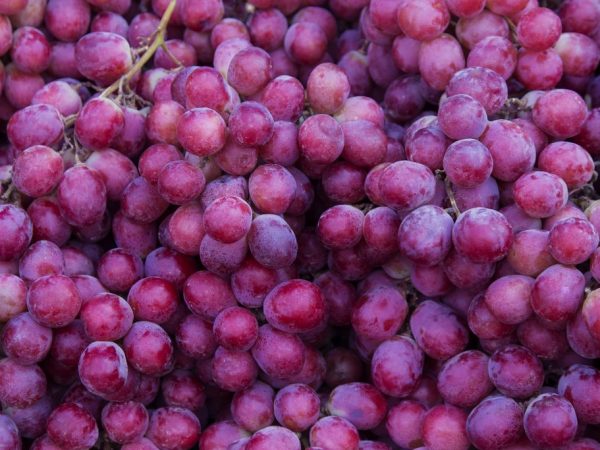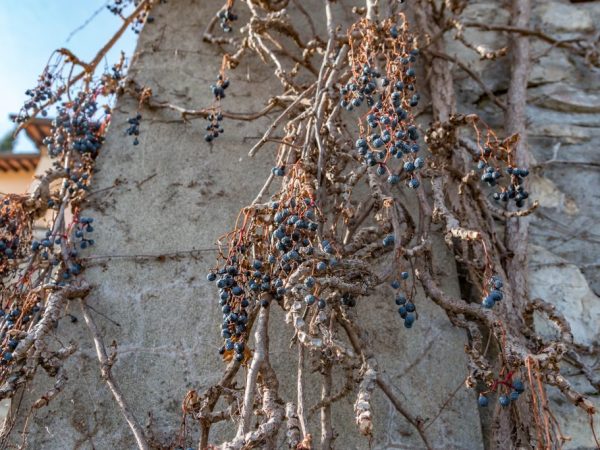Moscow uncovered grapes
Among the mid-ripening species, Moscow Bezakryvnaya grapes are distinguished by high frost resistance and unpretentiousness. The variety has large fruits. It is used for decorative purposes: arbors and arches are woven with vine. The variety is universal, excellent for the Moscow region. Not afraid of heavy loads.

Description of Moscow uncovered grapes
Characteristics of grapes
The culture is distinguished by good growth and fruiting rates in different areas. It is also grown in the northern regions.
From the beginning of budding to full maturity of the bunches, 115-130 days pass. According to the description, grapes have a number of positive qualities:
- good yield: on arched plantings, Moscow grapes yield 30-50 kg of fruit per bush;
- frost tolerance down to -35 ° С;
- excellent transportability;
- resistance to mildew, powdery mildew, gray rot.
The disadvantages include the fact that the culture is affected by other fungal diseases.
Description of the bush
The plant is vigorous. The vine is densely leafy. The leaves are large, five-toed, with slight pubescence. The grapes are self-pollinating, since the flowers are bisexual. The variety is used as a pollinator for plants with female flowers.
Description of fruits
The clusters are round, large, their weight is 400-500 g. The mass of berries is about 5 g. The color is blue-violet. The skin is firm. The pulp is juicy. The taste is sweet, harmonious. The amount of sugar is 18%. The fruits are an excellent antioxidant. Suitable for making wines and juices.
Growing grapes

Unpretentious grapes
Due to the unpretentiousness of the variety, even inexperienced gardeners can cultivate Moscow bare grapes.
Seat selection
It is better if the planting site is located on the south side of the garden. It must be protected from drafts and well lit. With a lack of light, fruits will not set. It is required that there is a gazebo or other structure nearby, then the vine will be able to curl, and it will become easier to care for the plant.
Acidic and loose soil is suitable for growing grapes, therefore, strongly acidic peat is introduced when preparing it for planting. They are also planted in sandy loam and stony soil.
Landing in the soil
The disembarkation process takes place at the end of May. Dig holes with a depth and diameter of 60 cm, with a distance of 1.5 m between them. If the soil is heavy, then crushed stone is laid on the bottom of the pit with a layer of 20 cm, on top - sod with grass down. The following fertilizers are also applied:
- 80 g superphosphate;
- 50 g of potassium chloride;
- a bucket of humus.
All components are mixed with earth. The seedlings are laid in the pit, straightening the roots. They fall asleep, the soil is compacted, watered abundantly. Pour a layer of mulch: straw, grass or sawdust. If a large number of seedlings are being planted at the same time, it is best to dig a trench. The grapes must be supported.
Plant care
The variety does not require special attention, but to get a bountiful harvest, it is worth following the rules. Recommended pruning is 4-8 eyes.They also break off unnecessary green shoots and leaves in the summer so that the plant does not thicken. This provides access to light and air, as a result, the crop ripens faster.
The variety is cold-resistant, so it is not sheltered for the winter. Some gardeners simply press it to the ground.
Fertilizer
In order for the grapes to develop well and bear fruit, top dressing is done according to the following principle:
- At the beginning of spring, complex mineral preparations are introduced.
- In summer, ammonium nitrate is used, which is canceled at the beginning of the ripening of the bunches.
- They introduce magnesium - an element that increases the immunity of the vine. It is used for foliar fertilization. For this, a solution is prepared: 150 g of sulfuric acid per 10 liters of water. Repeat after 2 weeks.
Nutrients are applied in 3 stages:
- when new shoots reach 10-15 cm;
- 10-15 days after flowering;
- before ripening berries.
Watering
In the first year after planting in cloudy weather, the plant needs to moisten the soil once a week, in hot weather - every other day. For the next season, the bushes are watered only in dry weather (once a week). It is impossible to swamp the site. The soil should be moistened 0.5 m deep. Water is not brought under adult plants. Watering is combined with dressing.
The soil is loosened regularly. Thanks to this procedure, oxygen is supplied to the root system. At the same time, weeds are removed so that they do not take on some of the food. To retain moisture and prevent the growth of weeds, the soil around the vines is mulched.
Diseases and pests
Moscow bezakryvnoy is immune to many diseases, but at temperatures above 27 ° C, there is a risk of infection by fungal pathogens. To combat ailments, plants are sprayed with a solution of copper sulfate or 1% Bordeaux mixture. The treatment is repeated after 1-1.5 weeks, since the action of the funds ends after this period.
Be sure to treat plants that were sick last year. Spraying promotes healing of small cracks, and also fights pests and their egg-laying.
Preventive actions are taken before the beginning of the flowering period. For this purpose, drugs "Ridomil", "Ordan" are used. During the ripening of the bunches, "Kurzat" and "Oksikhom" are used. All treatments are stopped 3-4 weeks before harvest.
Conclusion
According to the description, the variety Moskovsky bezakryvnaya tolerates frosts well and does not require additional protection in the cold season. It is an excellent option for growing in regions with harsh climates.
With proper care, the crop will delight the crop for 3 years after planting. If mistakes were made, fruiting will be delayed.


